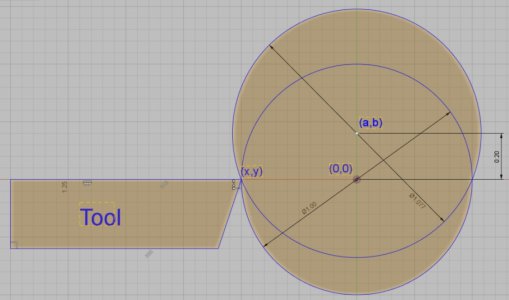- Joined
- Jan 22, 2012
- Messages
- 655
I am setting up my new PM1340GT lathe and have a question. I leveled the lathe on the long axis and across the two flat ways. I then installed a 2.5" dia by 12" aluminum bar in the chuck and after truing the bar I made a light cut (.002") at each end (bar only supported in the chuck). Over the 10" span I saw .008" taper with the headstock end being smaller than the tailstock end. I next extended the front adjuster foot on the tailstock end and made repeated light cuts measuring the 2 ends of the bar. I was able to get enough twist out of the bed to reduce the taper to .0015" over the 10" but at that point the rear adjusting foot at the tailstock end wasn't touching the floor anymore. After extending the rear foot until it made contact with the floor I made another cut and confirmed the taper didn't change. Here's the question.
Does this seem like an excessive amount of twist in the bed or more like the headstock isn't aligned properly with the ways? How do I tell which it is or which should be adjusted?
I'm not sure it's ok to have so little pressure on the one rear foot. Should I make the pressure on the feet more equal, which will make the taper increase again, and adjust the headstock to get the rest of the alignment needed to eliminate the taper seen on the test bar?
One other issue. After leveling the lathe, when I was truing up the bar supported by a dead center I was seeing a lot of vibration/shake, enough that the light was moving and I could feel it in the headstock and carriage controls. As I increased the pressure in the front foot the vibration got less and less until I had gotten out about .005" of the original 008" of taper and then started to increase again. Another indication of loading on the feet not being equal enough to keep the lathe stable?
Another option would be to adjust the feet until the lathe runs smooth without shake and then just adjust the headstock to get rid of the taper in the test bar.
Any other ideas?
Does this seem like an excessive amount of twist in the bed or more like the headstock isn't aligned properly with the ways? How do I tell which it is or which should be adjusted?
I'm not sure it's ok to have so little pressure on the one rear foot. Should I make the pressure on the feet more equal, which will make the taper increase again, and adjust the headstock to get the rest of the alignment needed to eliminate the taper seen on the test bar?
One other issue. After leveling the lathe, when I was truing up the bar supported by a dead center I was seeing a lot of vibration/shake, enough that the light was moving and I could feel it in the headstock and carriage controls. As I increased the pressure in the front foot the vibration got less and less until I had gotten out about .005" of the original 008" of taper and then started to increase again. Another indication of loading on the feet not being equal enough to keep the lathe stable?
Another option would be to adjust the feet until the lathe runs smooth without shake and then just adjust the headstock to get rid of the taper in the test bar.
Any other ideas?


